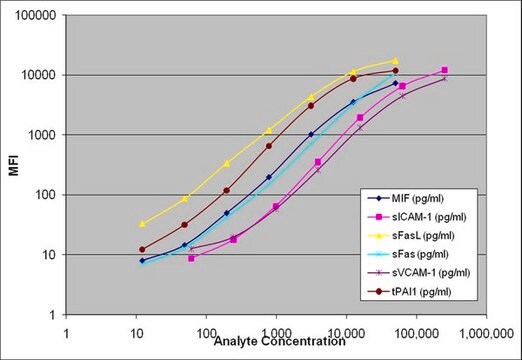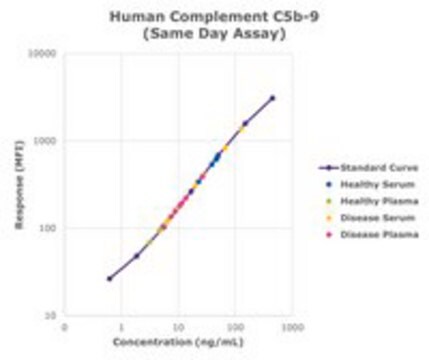03-0207-00
SMC® Human PD-1 High Sensitivity Immunoassay Kit
Synonym(s):
PD-1 Single Molecule Counting kit, PD-1 ultra-sensitive immunoassay, PD-1 immunoassay kit, Programmed cell death protein 1 kit, PD-1 kit
About This Item
Recommended Products
species reactivity
human
Quality Level
parameter
50 μL sample volume (diluted 2-fold in standard diluent)
assay range
intra-assay cv: ≤5%
(n=15)
linearity: 80-117%
(Plasma)
linearity: 91-135%
(Serum)
recovery range: 53-100%
(Plasma)
recovery range: 80-109%
(Serum)
sensitivity: 1.74 pg/mL
standard curve range: 0.87-3,000 pg/mL
inter-assay cv: ≤14%
(n=15)
technique(s)
single molecule counting: suitable
input
sample type plasma (K2 EDTA)
sample type serum
shipped in
wet ice
storage temp.
2-8°C
General description
Research Category: Cancer
Research Sub-Category: Immuno-Oncology
Specificity
Application
Features and Benefits
- Accurate and reproducible performance on the state-of-the-art SMCxPRO® ultrasensitive immunoassay system.
- Compatiblity with automated liquid handling
Legal Information
Disclaimer
Signal Word
Danger
Hazard Statements
Precautionary Statements
Hazard Classifications
Acute Tox. 4 Dermal - Acute Tox. 4 Inhalation - Acute Tox. 4 Oral - Aquatic Chronic 3 - Eye Irrit. 2 - Repr. 1B - STOT RE 2 Inhalation
Target Organs
Respiratory Tract
Storage Class Code
6.1C - Combustible acute toxic Cat.3 / toxic compounds or compounds which causing chronic effects
Certificates of Analysis (COA)
Search for Certificates of Analysis (COA) by entering the products Lot/Batch Number. Lot and Batch Numbers can be found on a product’s label following the words ‘Lot’ or ‘Batch’.
Already Own This Product?
Find documentation for the products that you have recently purchased in the Document Library.
Related Content
Explore how to select the best immunoassay platform for your research by choosing between multiplex and singleplex biomarker detection assays, immunoassay instrument platforms, immunoassay software, and services.
See an overview of ultrasensitive immunoassay technology with Single Molecule Counting (SMC®) technology, including its workflow, biomarker detection platform, research areas, advantages of high sensitivity SMC® assays, and more.
See how to enhance your immunology research through the power of high sensitivity immunology assays by harnessing SMC® technology to precisely characterize low-abundant cytokines like those from Th1/Th2 and Th17 cells.
Our team of scientists has experience in all areas of research including Life Science, Material Science, Chemical Synthesis, Chromatography, Analytical and many others.
Contact Technical Service










